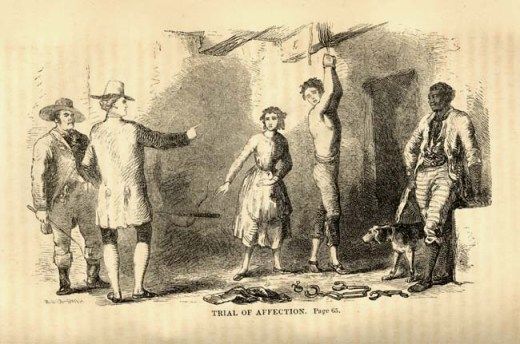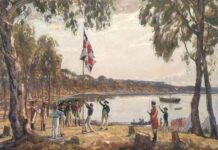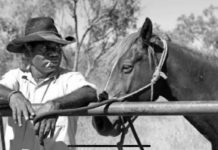Originally published at Patriotic Alternative on 30 June 2021.
By Johnny Alba
In the early hours of the 20th of June 1631, under the cover of darkness a group of men made their way quietly ashore from boats resting off the coast of the Irish town of Baltimore. Under the direction of their captain, a Dutch convert to Islam called Morat Rais they made their way to a small settlement of 26 houses known as Cove, 2km from the main village of Baltimore.
The landing party made of Dutch converts to Islam, Algerians and Ottoman Turks quietly positioned themselves at the doorways of each house and waited for a signal from their captain. On his order they used iron bars to smash their way into the cottages seizing 100 villagers. The captain then left 60 of his men to form an ambush along the track to the main settlement and made his way to the town with another force of 100 plus men.
Arriving quietly in the town they then forced their way into another 40 houses, ransacking 37 of them before a local man William Harris fired a musket at the slavers alerting the rest of the town to their presence. At this point Morat Rais realised he had lost the element of surprise and retreated to the settlement of Cove. When they arrived there, they lost no time in returning to their boats along with their captives. In total they had abducted 20 men, 33 women and 54 children and youths. In addition to these people, they had already captured 10 men from a trading vessel and 10 other men from two fishing boats. Between 3 and 4 pm they then set sail with their captives on their journey back to Algiers and its slave markets.
Treated Harshly
It is recorded in various accounts that when the Barbary pirates, as these raiders were known, made off with their captives, they treated the men very harshly to “break” them. Any man who caught his captor’s attention was severely beaten and, in some cases, hacked to death in a bloody frenzy. Accounts state that on the whole women and children were treated much better, probably not due to any kindness on the part of the Barbary Pirates, but just down to the simple economics that they were worth far more than the male captives. They arrived in Algiers on the August 10th and the captives were sent to the slave markets. The English consul there asked for funds from England to ransom them but by then the Government had already instigated its policy of not paying ransoms. At most three people captured in the raid ever returned to Ireland with one lucky enough to be ransomed almost immediately and two others in 1646. The rest were destined to spend a life of harsh slavery usually either as galley slaves on Muslim ships where they would never set foot on land for years or as labourers. Many of the women were destined to spend most of their lives in harems across north Africa and the middle east. For anyone interested to learn more on the raid there is a very good book called The Stolen Village: Baltimore and the Barbary Pirates.

This raid was not an unusual event in European history. Such incidents had happened from about 710 onwards after the Muslim conquest of the Iberian Peninsula. But they became much more frequent in the 16th century and peaked during the 17th century, when the towns of Algiers, Tunis and Tripoli which were the slavers’ main bases came under the control of the Ottoman Empire as the Barbary states. The raids carried on for centuries and led to the English (later British) navy launching various attacks on the bases in the Barbary coast. After the independence of the United States from Britain, the Americans lost the protection of the British naval forces and the Barbary pirates launched frequent attacks on American trading vessels. This at first led to the newly independent American nation paying tribute and ransoms, which amounted in 1800 to 20% of the American government’s expenditure, until Thomas Jefferson refused to pay tribute anymore and recommissioned the American Navy. A situation that the led to the First and Second Barbary wars. Even this did not end the Barbary pirates’ activities with large raids such as one in Sardinia in 1798 when 900 captives were taken by raiders from Tunisia. Pirate activity from Tunis did not finally cease until 1840 when France captured the town.
The slavers did not just raid vessels in the Mediterranean but ventured as far north as the British Isles, the Netherlands, Iceland and even across the Atlantic to Newfoundland. It is estimated that at times the Barbary pirates’ trade in white slaves far exceeded the slave trade from Africa to the New World. It is estimated that between 1580 to 1680 alone over 850,000 slaves were taken from Europe by the Barbary pirates. The numbers over the whole period of the Barbary pirates’ activity certainly range well into the millions of victims. Between 1606 and 1616 Britain alone lost 466 merchant ships to the Barbary pirates, it must be remembered that the main reason for attacking these ships was not like other pirates for booty but specifically to take white slaves for the North African, Ottoman and Middle Eastern slave markets. A good book on the North African slave trade for anyone interested is White Gold; the extraordinary story of Thomas Pellow and North Africa’s one million white slaves.
The Barbary pirates were but one part of an extensive trade in white slaves. It is estimated that between 1450 and 1700 over 2.5 million white slaves were taken from the Black Sea region to Istanbul’s Ottoman slave markets. Also, under the Dervsimre-Janissary system it is estimated that between the 14th to 18th centuries anywhere from 500.000 and one million white European boys between the ages of 8 and 18 were forcibly removed from their families, converted to Islam and forced to serve as soldiers and administrators of the Ottoman empire. Officially the slave trade in the Ottoman empire was suppressed in the 19th century but as late as 1913-16 there were reports of white women being sold as slaves on Ottoman territory and Armenian women in the 1915 genocide were reported as being sold as sex slaves. With the modern trade in Eastern European women amongst others to work as sex workers in the Middle East, and for mainly Albanian and Turkish/Kurdish gangs in Europe, one must wonder if the trade in white slaves has ever really stopped.
Indentured Servants
The Muslims of North Africa, the Ottoman Empire and other parts of the Middle East were not the only ones responsible for the white slave trade. The poor of Britain, Ireland and many other European countries were treated as indentured servants during the 17th and 18th centuries. With many being transported to the Americas to work in the fields and undertake other labour. The Harvard Professor David Brion Davis wrote in his book In the image of God: Moral values and our heritage of slavery:
“From Barbados to Virginia, colonists long preferred English or Irish indentured servants as their main source of field labour; during most of the seventeenth century they showed few scruples about reducing their less fortunate countrymen to a status little different from chattel slaves – a degradation that was being carried out in a more extreme and far more extensive way with respect to the peasantry in contemporary Russia. The prevalence and suffering of white slaves, serfs and indentured servants in the early modern period suggests that there was nothing inevitable about limiting plantation slavery to people of African origin.”
It is estimated that between that between the 1630s and the American Revolution between 50% and 67% of the white immigrants to the American colonies were indentured servants. Many of them were working to repay debts, with the hope of some future payment or passage to the New World but many were also taken out of the poorhouses, prisons and streets of European cities and traded for profit in the colonies and as a way to get rid of the poor and sick. The labourers could be bought and sold between masters. The abuse of female indentured servants was very common and conditions for all were usually very harsh and their rights limited. Runaways were chased down and returned to their masters when they were brutally punished.

White indentured servants also existed in the Caribbean plantations. It is estimated that before 1840, 500,000 white Europeans were sent to the Caribbean. During the War of the Three Kingdoms at least 10,000 Irish and Scottish prisoners were transported. In theory, after five to seven years most were meant to be freed, but many were not or perished due to ill treatment.
Hot Topic
The history and legacy of slavery has been a news topic for the last few years and it may puzzle many readers that they have probably never heard of white slavery. These slaves were treated every bit as badly as the black slaves of the trans-Atlantic trade but their suffering has never been publicised or spoken about by so called anti-slavery campaigners. How many of the museums dedicated to slavery tell their stories? You can be sure if they do it will be as a footnote or played down as has already happened, with many activists decrying the Irish slavery trade as a myth, which it is not. How many of the reviews into art collections, monuments and street names taking place all over Europe and the Americas will take into account the stories of Europe’s white slaves? How much talk of reparations will there be for the villages and families devastated by the Muslim slave trade? There is much talk of how the cloud of slavery still hangs over the black population of America disadvantaging them, but it does too over the poor descendants of white indentured servants. The term redneck, a derogatory term for first poor whites slaving in the fields is a racist word borne out of this system. Jim Goad wrote a very good book called the Redneck Manifesto on the indentured white servants of America and how their descendants are still discriminated against even today.
It appears that the terrible history of slavery imposed on the white European peoples will continue to be ignored. We will continue to be bombarded by the media with tales of black slavery and how we with our white supremacy and white privilege are all responsible for it. How we must be prepared to sacrifice to give justice to the black slaves of the past, but where is the justice for our white slaves?









